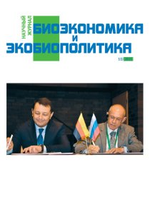Aminonitroxyl Platinum Complexes as Antitumor Compounds
Авторы: Терентьев А. А., Senj V. D.
Рубрика: Тезисы
Опубликовано в Биоэкономика и экобиополитика №1 (1) декабрь 2015 г.
Дата публикации: 15.01.2016
Статья просмотрена: 9 раз
Библиографическое описание:
Терентьев, А. А. Aminonitroxyl Platinum Complexes as Antitumor Compounds / А. А. Терентьев, V. D. Senj. — Текст : непосредственный // Биоэкономика и экобиополитика. — 2015. — № 1 (1). — URL: https://moluch.ru/th/7/archive/20/645/ (дата обращения: 25.04.2025).
Platinum based drugs have long history of successful cure of a number of cancers, but their clinical use is restricted because of severe side effects and resistance (intrinsic or acquired) of tumors to these drugs. We have synthesized a series of aminonitroxyl tetravalent platinum complexes of common structure Pt(IV)(NH3)(R•NH2)Y2Cl2, where R is a nitroxyl radical and Y is an axial ligand, and studied their effects on tumor cells of several lines. The axial ligands of synthesized complexes are the residues of fatty acids of different lengths. These ligands can change lipophilicity of the complexes which is important for their ability to penetrate into cells. The nitroxyl radical moiety was introduced into the platinum complexes because it is known that nitroxyl radicals possess antioxidant properties. Since reactive oxygen species generation and oxidative stress were observed in cells and organs of animals exposed to platinum based drugs, the antioxidant nitroxyl moiety could confer less toxicity.
It was found that introduction of nitroxyl radical to structure of Pt(IV) complexes drastically decreased the cytotoxicity of resulting compounds. Placing fatty acids at axial positions of tetravalent platinum complexes allowed us to obtain complexes that possess cytotoxicity exceeding that of original Pt(IV) componds. Cellular accumulation of aminonitroxyl Pt(IV) complexes depends on structures of their axial ligands. The direct nitroxyl derivatives of Pt(IV) complexes have the slowest accumulation rates, while complexes with modified axial ligands exhibite higher rates of cellular accumulation.
In experiments with pulse exposure, the aminonitroxyl Pt(IV) complexes have been shown to develop their cytotoxic effect much slower compared to cisplatin. Thus, despite high cellular accumulation rates, aminonitroxyl Pt(IV) complexes compounds require an additional time to reach their high cytotoxicity. This suggest that the Pt(IV) complexes are prodrugs that have to be reduced to active Pt(II) derivatives to exert their antitumor activity.
Antitumor effects of aminonitroxyl Pt(IV) complexes is compared to that of cisplatin, but aminonitroxyl complexes are several fold less toxic to animals. In experiments with combination therapy of model animal tumors a synergistic action of aminonitroxyl Pt(IV) complexes and cyclophosphamide or cisplatin was observed, resulting in high survival rates of tumor bearing animals.







